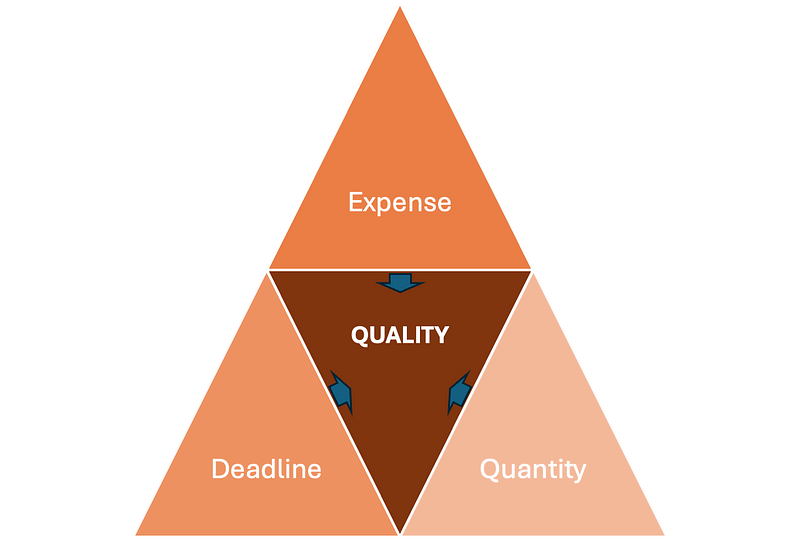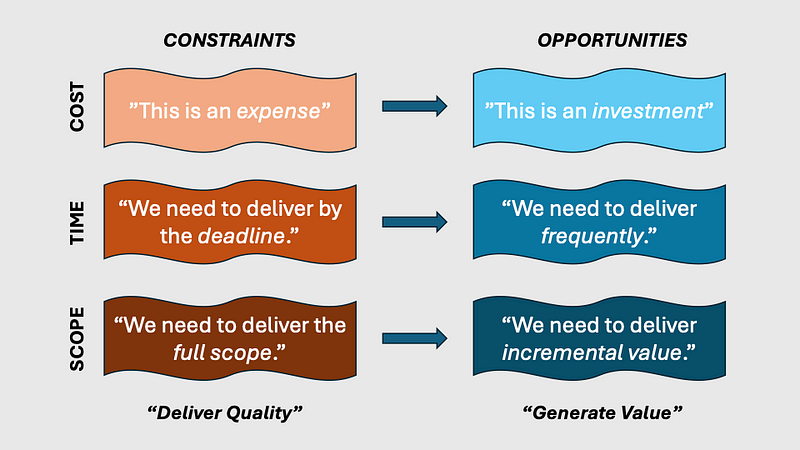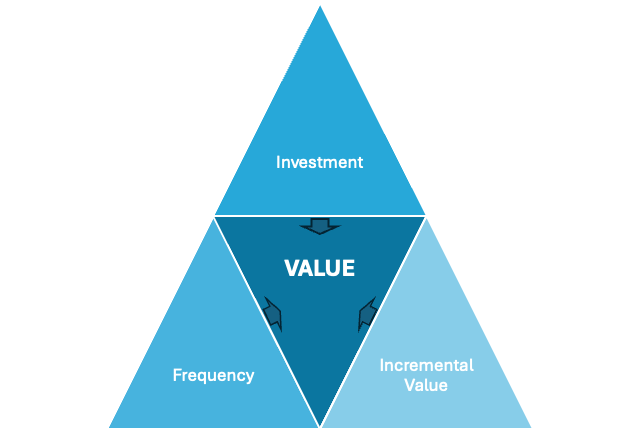Mind-Shifting: How Leaders Can Turn These 3 Constraints into Opportunities (the Value Triangle)
Cost, Time, and Scope.
Those are the magic ingredients that drive successful projects, right?
Not quite, and in this article I will discuss exactly why those traditional measures are outdated and what you as a leader should be doing to stay ahead of the curve.
But before we go there, let’s take a brief look at what we refer to as the Iron Triangle.
“The success of a project is impacted by its costs, time, and scope. As a manager, you can ensure successful projects by balancing these three constraints through trade-offs.” — Project Management Lore
The Traditional Iron Triangle

But what are these constraints, and why do they matter?
Constraint #1. Cost
There’s no such thing as a free lunch.
The financial expenses form the central pillar of the iron triangle. You need to manage costs, budget resources, allocate funds, and make sure you don’t overspend beyond what was allocated to the project.
You need to hold on to the purse strings. And hold them tight.
Constraint #2. Time
Dates and deadlines are an essential aspect of running a project.
You have customer deadlines, delivery deadlines, and marketing deadlines. You need to meet those deadlines to ensure your project succeeds. You need to constantly manage stakeholder and customer expectations by sticking to the timeline and ensuring you are tracking to it.
If you miss a deadline, that can have a cascading impact on both cost and scope.
And nobody likes that. Not even your boss (pun intended).
Constraint #3. Scope
What is being delivered?
The scope captures the project’s deliverables — the objectives, the features, the boundaries. As a leader, you need to pay attention to the scope and make sure what was promised is being delivered.
You cannot promise a horse but deliver a donkey.
Changes in scope can be a nightmare for managers. An increase in scope can affect both the cost, and the time, and throw the entire project off its trajectory if not managed properly.
The Interplay of Constraints
Cost, time, and scope are the constraints.
These are the levers that you can play with. Adjusting one constraint will invariably affect the others.
For example, if you expand the scope of a project, you may need more time to deliver it with the same resources. Or, you may hire more resources to deliver it at the same time. Another example: if you need to cut costs, you may need to either reduce the scope of the project, or extend the timeline.
The Challenge with Constraints
The iron triangle may be a valuable theoretical concept. But just how relevant is it in today’s landscape?

The iron triangle maps the three constraints as follows:
- Cost is treated purely as the “Expense” of executing the project.
- Time is treated as the “Deadline” by which the project should be delivered
- Scope is treated as the “Quantity” of the output
So the triangle is primarily focused on the “quality” of the project, while managing the expense, the deadline, and the quantity of the deliverable.
This framework was originally introduced in 1969 in the context of Contract Costing, and was used to plan and execute traditional projects. In today’s age, this traditional method is being challenged by new, smarter approaches that emphasize continuous improvement, iterative development, collaboration and rapid execution.
We need to move away from Constraints, and focus on Creativity.
The Mind-Shift: Constraints to Opportunities
The world is a completely different place today.
There are continuous technological advances, and massive collaboration due to the widespread availability and adoption of the internet, resulting in the blurring of traditional market boundaries. There is cut-throat competition, and the desire to capture a piece of the large pie that is now available.
Human behaviors have adapted to technology. People have less patience, they are spoilt with options, and they expect fast results. They are looking for value, and specifically, value that is contextual to them. Also, people are more open to trying different solutions and products as long as they offer them the value they’re looking for.
This is driving business leaders like you to shift the 3 levers from constraints to opportunities.

Opportunity #1. Investment
Cost, which was traditionally seen as an expense, is now seen as an investment.
This is a major shift, and you need to invest in the future, not just the present. You need to think strategically about their opportunities and threats, and invest your resources so you are not left behind. This includes investments in research and development, even if those investments are not being directly applied to current projects.
“I’m here to build something for the long-term. Anything else is a distraction.” — Mark Zuckerberg
Opportunity #2. Frequency
Time, which was traditionally seen as the lever to manage deadlines, is now seen in the context of frequency.
In many ways, this has put a spotlight on internal operations and efficiency of execution. How quickly and efficiently you can release new capabilities, fix issues, and respond to customer escalations is now the key driver of time. Agility is the new clock.
“Speed, agility and responsiveness are the keys to future success.” — Anita Roddick
Opportunity #3. Incremental Value
Scope, which was traditionally used to capture the quantity of work being delivered, is now used to capture the incremental value.
There is no point in delivering a large feature that nobody will use. Instead, you should be able to deliver incremental value fast, get feedback, and iterate on that. Thus the idea of frequency and incremental value go hand in hand and complement each other.
“You can create value with breakthrough innovation, incremental refinement, or complex coordination. The very best companies do all three.” — Sam Altman
Bringing it together: The Value Triangle

Ultimately, it is the value that you deliver that defines your success.
Customers are less concerned with meeting arbitrary deadlines or staying within a fixed budget if the resulting product or service fails to meet their needs or expectations. They are open to trying and testing incremental enhancements, and participating in trials and betas to help improve the quality.
In today’s landscape, you need to focus on delivering value by adopting the modern levers available to you as a leader:
- You need to think strategically and invest in research and development to stay ahead of the curve. You need to be aware of the opportunities and threats ahead, and have a game plan to tackle that.
- You need to optimize, modernize, and automate your internal operations and delivery mechanisms so you can deliver value at a high frequency, and respond to customer issues quickly.
- You need to focus on delivering incremental value, and iterate on the shape and direction that the product takes based on the feedback you receive.
It’s a mind-shift: from constraints to opportunities.
Like my writing?
If you liked this post, I would appreciate some claps👏 as a form of encouragement. Thank you!
To read similar content you can follow me and subscribe to get these posts delivered directly to your Inbox. Check out my bio for other ways to connect with me.
Feedback is a gift! I would love to hear your thoughts and suggestions in the comments below 🙏





